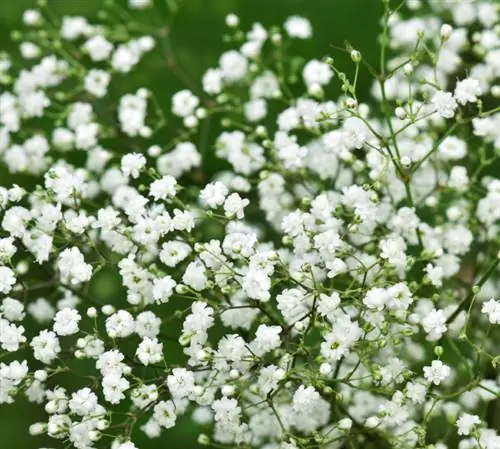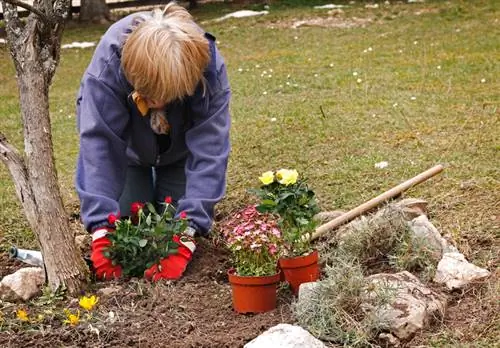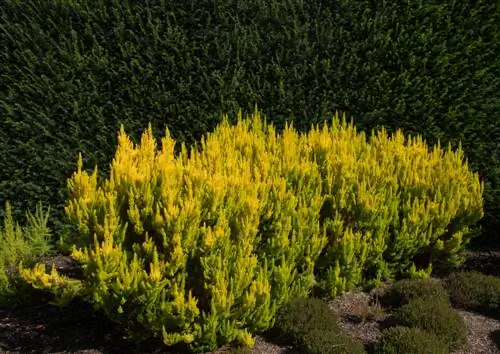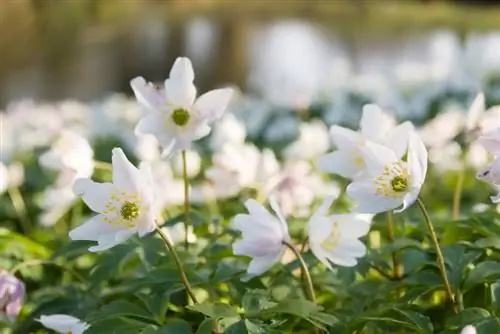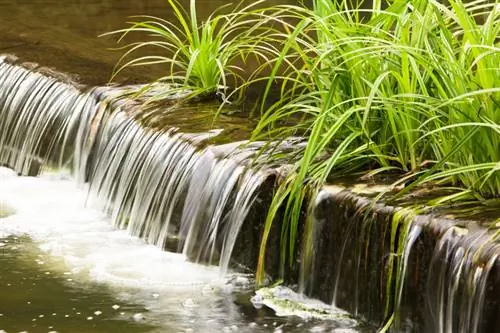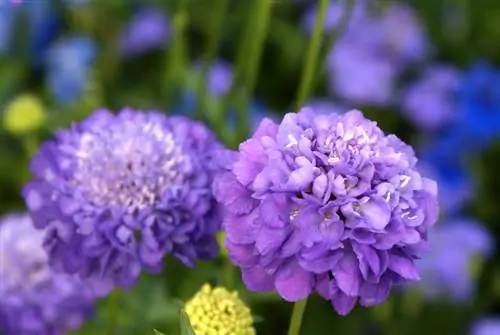- Author admin [email protected].
- Public 2023-12-25 17:45.
- Last modified 2025-01-23 11:22.
With countless white or pink star blossoms, baby's breath creates floral opulence in the sunny cottage garden, the rose bed or sandy-dry herbaceous borders. The lush perennial is far too good to be reduced to its function as an addition to the bouquet. Explore all relevant details about cultivating Gypsophila paniculata here.
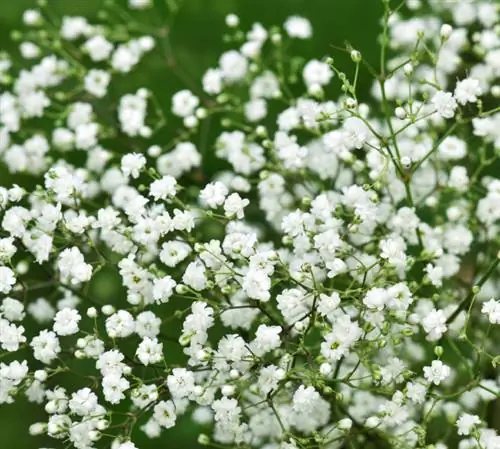
How do I care for baby's breath (Gypsophila paniculata) in the garden?
Gypsophila (Gypsophila paniculata) is a perennial known for its lush clouds of white or pink flowers. It prefers full sun, dry locations with sandy-gravelly soil, requires little water and does not use fertilizer. Cut back spent stems to encourage rebloom.
Planting gypsophila correctly
Assign gypsophila to a full sun location where poor, sandy-gravelly soil dominates. The finer the soil is prepared, the more vital the fleshy, strong root system will develop. If you have concerns about permeability, add fine grit, gravel or sand to the substrate. Compost or other organic soil additives have no place on Gypsophila paniculata. This is how you plant gypsophila correctly:
- Place the still potted root ball in a container with water
- Meanwhile, dig a spacious planting pit
- Create a small hill at the bottom to place the potted root ball on top
- Fill with substrate up to the bottom pair of leaves, press down and water
The small hill of coarse-grained substrate effectively prevents waterlogging. In addition, this gardening trick helps ensure that constant winter wetness does not cause root rot.read more
Care tips
It is amazing how short a care program results in the long flowering period of Gypsophila paniculata. While fertilizing should be avoided at all, watering can still be considered in summer droughts. Cutting the spent stems back to the foliage will attract a second set of flowers. Cut the gypsum weed down to just above the ground in late winter. If you spread a layer of brushwood over the bed when it is wet in winter, this caution will protect the perennial from root rot.read more
Which location is suitable?
Native to the sun-drenched, dry, hot regions of southern Europe, baby's breath feels particularly comfortable in full sun in rock gardens and gravel beds. The soil should be sandy, gravelly, poor and dry so that the airy flower clouds thrive. There shouldn't be any signs of waterlogging far and wide, because the magnificent perennial is not made for damp, wet soil.read more
The correct planting distance
A cleverly chosen planting distance makes a significant contribution to ensuring that Gypsophila paniculata can spread its airy, light veil of flowers in a harmonious look. We have put together recommended planting distances for you to suit the different growth heights and widths:
- Growth height 10-15 cm and width up to 30 cm results in a planting distance of 20-30 cm
- Growth height 20-30 cm and width 60-80 cm results in a planting distance of 80 cm
- Growth height 30-40 cm and width 20-30 cm results in a planting distance of 30 cm
- Growth height 80-100 cm and width 40-80 cm results in a planting distance of 50 cm
- Growth height 100-120 cm and width up to 80 cm results in a planting distance of 70 cm
What soil does the plant need?
Wherever the soil is sandy-gravelly, dry, lean and calcareous, Gypsophila paniculata unfolds its graceful flower beauty. The creeping species decorate the crown of a dry stone wall in an inimitable way, while the gypsum herbs towering high towards the sky provide a summery rendezvous in the well-drained soil of the rock garden. For potted plants, we recommend a lean herbal soil as a substrate, to which you add vital lime or rock dust as well as fine grit or sand.
What is the best time to plant?
So that delayed ground frosts do not affect the delicate flower veil of Gypsophila paniculata, choose a planting time from mid-May onwards. If you prefer autumn as the classic time for planting perennials, you cannot avoid adequate winter protection for the young plants. The effort will be rewarded with an early start to the flowering period next year from mid-April.
When is flowering time?
If you arrange early-blooming species with later-blooming gypsum herb, the fragrant flower clouds will float through the garden all summer long. Low cushion gypsophila (Gypsophila repens), for example, blooms from May to July, while panicled gypsophila (Gypsophila paniculata) blooms from June to September.read more
Cut gypsophila correctly
The pivotal point of professional care for Gypsophila paniculata is the right cut. How to handle the issue with expertise:
- Cut off withered flower spikes after the first flowering to encourage gypsophila to bloom again
- The first cut back is down to the leaves
- You can either leave the after-flowering for self-sowing or cut it off down to the first pair of leaves
- Do not prune close to the ground until early spring
Use Gypsophila paniculata as a vase decoration or addition to a bouquet, cut the flower stems in the early morning when two thirds of all buds have opened.read more
Watering gypsophila
The additional supply of water is of secondary importance for the growth and abundance of flowers of a Gypsophila paniculata. Only water the gypsum herb a little when it is dry in summer. Cultivated in a bucket, watering is only necessary when the top 5-6 cm of the substrate is dry.
Fertilize baby's breath properly
Gypsophila is one of the rare exception plants on which the application of fertilizer in any form has a counterproductive effect. Even the use of a mulch layer made of organic materials has negative effects on Gypsophila paniculata, up to and including complete refusal to flower.
Diseases
If a gypsophila languishes while the base of the stem turns dark, the plant is suffering from a fungal infection. Various types of spores may be the culprits, all of which cause similar symptoms. Dig up the infected perennial widely to prevent it from spreading further in the garden. To ensure that the dilemma does not repeat itself, you should not expose Gypsophila paniculata to waterlogging, always keep the soil permeable and do not give nitrogen-rich fertilizer.
Pests
Snails and rabbits like to eat gypsophila. Since you are dealing with two stubborn and rabid predators of the magnificent perennial, the following precautions are essential:
- Plant Gypsophila paniculata with snail collar in snail-infested areas
- Lay out barriers around the bed or erect a snail fence
- If the infestation pressure is high, set up crack traps with slug pellets
You can keep wild rabbits away from the property with a fence made of rabbit wire that reaches 30 cm deep into the ground. In addition, specialist retailers offer special deterrents that will cause rabbits to run away when used.
Wintering
Gypsophila paniculata thrives as a completely hardy perennial. While the above-ground parts of the plant are withdrawn over the course of the winter, the root ball in the ground survives even the lowest sub-zero temperatures undamaged. The only problem is too much winter moisture, so we recommend covering large areas with brushwood. In the pot there is a regular risk that the almost unprotected root ball will freeze. Therefore, wrap containers in bubble wrap and place them on wood.
Propagate baby's breath
The busy summer bloomer brings so much joy to the ornamental garden that there is a desire for more specimens. Choose from the following propagation procedures, all of which are straightforward:
- Cut cuttings to root in the poor substrate during the summer
- Dividing the root ball in spring or autumn
- Sowing behind glass from March
read more
How do I transplant correctly?
Since Gypsophila paniculata develops a strong, fleshy root system, transplanting the perennial is risky. If a change of location is still unavoidable, choose a date in spring. In this way, there is a sufficiently long period of time for re-rooting until winter. Cut off the lateral roots in a radius that approximately corresponds to the growth height of the gypsum herb. As an exception, the plant is watered repeatedly in the new bed location in order to encourage the formation of fresh fine roots.
Gypsophila in a pot
With gypsophila in the pot, the sunny balcony is transformed into a sea of white and pink flowers. To enjoy this splendor all summer long, use a lean herbal or potting soil as a substrate. Add fine gravel or sand to ensure the desired permeability. A potsherd drainage above the water drain prevents harmful waterlogging. Only water Gypsophila paniculata when it is dry and do not apply fertilizer. If you cut the first flower floret down to the foliage, with a little luck a late summer bloom will appear. Before the first frost, wrap the pot in foil or carry it to a frost-free winter quarters.read more
Is gypsophila poisonous?
In small doses, gypsophila has a healing effect that is aimed at mild discomfort in the throat area. Gypsum herb has long since lost its importance in folk medicine. The saponins contained in Gypsophila paniculata, however, cause significant symptoms of poisoning in large quantities in humans and animals. Therefore, do not leave small children and pets unattended within the reach of gypsophila.read more
Can gypsophila be dried?
It seems like magic and is rather rare in the flower kingdom, because Gypsophila paniculata hardly loses any of its natural beauty after drying. To preserve the delicate flower spikes for a long time, proceed as follows:
- Cut off the blossomed stems when they are dry
- Remove the leaves at the bottom
- Tie the gypsophila in small bouquets with raffia
Hung upside down in an airy, dark and rainproof place, the flowers dry within a few days. As the moisture escapes from the stems, lightly tighten the binding material. Then store the gypsophila at room temperature so that it does not start to trickle.read more
Beautiful varieties
- Bristol Fary: Delicately branched Gypsophila paniculata with white flowers over blue-green foliage; Growth height 80-100 cm
- Rosenveil: Soft pink, double spherical flowers characterize this very compact variety; Growth height 30-40 cm
- Flamingo: The variety impresses with pink flower clouds and a long flowering period until autumn; Growth height up to 120 cm
- Snowflake: Tall gypsophila in a class of its own with white, fragrant flowers; Growth height up to 100 cm
- Compacta Plena: Double gypsophila in white, ideal for the balcony box thanks to its overhanging growth; Growth height 30 cm

